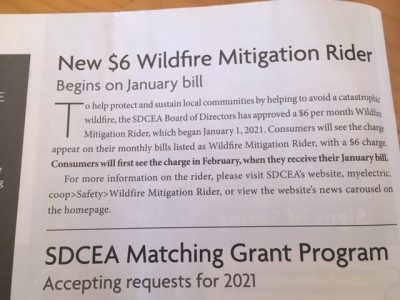In its February Newsletter, Sangre de Cristo Electric Company (SDCEA), an energy cooperative based in Buena Vista, included an alert that its January billing which arrives in Feb. would include what it refers to as their Wildfire Protection Rider.
“For years we budgeted hundreds of thousands of dollars for vegetation management and property owners would chase us off their property, and threaten lawsuits for us cutting their trees. Even though it is in our right-of-way and our easements,” said CEO Paul Erickson. “So our policy for many years was trimming trees and cutting them back, rather than cutting them down. We were trying to be friendly to our member-owners. So we were falling behind on wildfire mitigation. We doubled our budget just to cut back trees.”
SDCEA in recent years has budgeted and spent $540,000 annually from its general fund for vegetation management. Given the accelerated wildfire danger, SDCEA determined that at that funding level, it could take up to 20 years to effectively clear their lines.
Chaffee, Fremont, and Park counties have seen three wildfires in the region in the past five years. Across the state, last summer was the worst wildfire season in the history of Colorado, and drought conditions are increasing across the west. The catastrophic California wildfires in the past two years have been partially blamed on the public utility companies, and local leadership wants to reduce the wildfire risks associated with the county’s power infrastructure.
Erickson said that with about 1,000 miles of overhead power lines in rugged terrain in parts of five counties, Sangre de Cristo has the highest electric rates in the state. “We are under tremendous pressure to keep rates down — and continuing to cut trees back. But with wildfire danger rising, we just couldn’t continue the current practice. So the board began evaluating this and took the bold step of instituting a rate rider that is required to be spent 100 percent on wildfire mitigation … it’s a restricted fund.”
He noted that about the same time Xcel Energy did the same thing — but with one big difference. “While Xcel’s is based on consumer electric use, ours is a rate per meter — which means that second homeowners are paying their fair share of the wildfire mitigating rider.”
Erickson says the $6 per month fee per meter to customers was approved by its board of directors as a way to help the company do advance safety planning and mitigation around its energy infrastructure. (It’s not called a rate increase. Rates are charged based on how much electricity you use each month and SDCEA hasn’t imposed a rate increase since 2017) .
The rate rider charge is a standalone charge that is specifically earmarked for wildfire mitigation through augmented vegetation management efforts. While the fee begins at $6 per month, there will be a gradual increase of $1 per year until it reaches $10, which will remain in effect until the board determines that this wildfire mitigation rider is no longer necessary.
“The wildfire threat in our region is clear, and we must take action to help prevent one here as soon as possible,” says Erickson. “My gosh, if we haven’t learned anything from what happened in California …. our highest calling is the protection of life and property.”
SDCEA concluded that it didn’t have time to work through the existing system to address what is an immediate threat. The rate rider was adopted to fund an accelerated response to this issue. The fee is being assessed per meter.
The SDCEA Board of Directors opted to approve an incremental monthly increase each year, up to a maximum of $10, to lessen the immediate impact of the rider on consumers. The rate rider, as well as the rest of the rate schedule, are posted online at myelectric. coop. The information can be accessed through your account once signed in on Smarthub, under “My Documents”.
The company was already using a company out of Michigan called Integrity Tree Service to conduct the vegetation mitigation. “This has had a silver lining,” says Erickson. “The company we recruited from Michigan a few years ago is now opening a satellite office here in the county. It has already created jobs here and they are advertising four more positions. We’ve been working with the Office of Economic Development. It really is making lemonade out of lemons.”
Another immediate project: a 2021 drone survey of SDCEA’s entire overhead system.
For more information about SDCEA go to: https://www.myelectric.coop/









Recent Comments